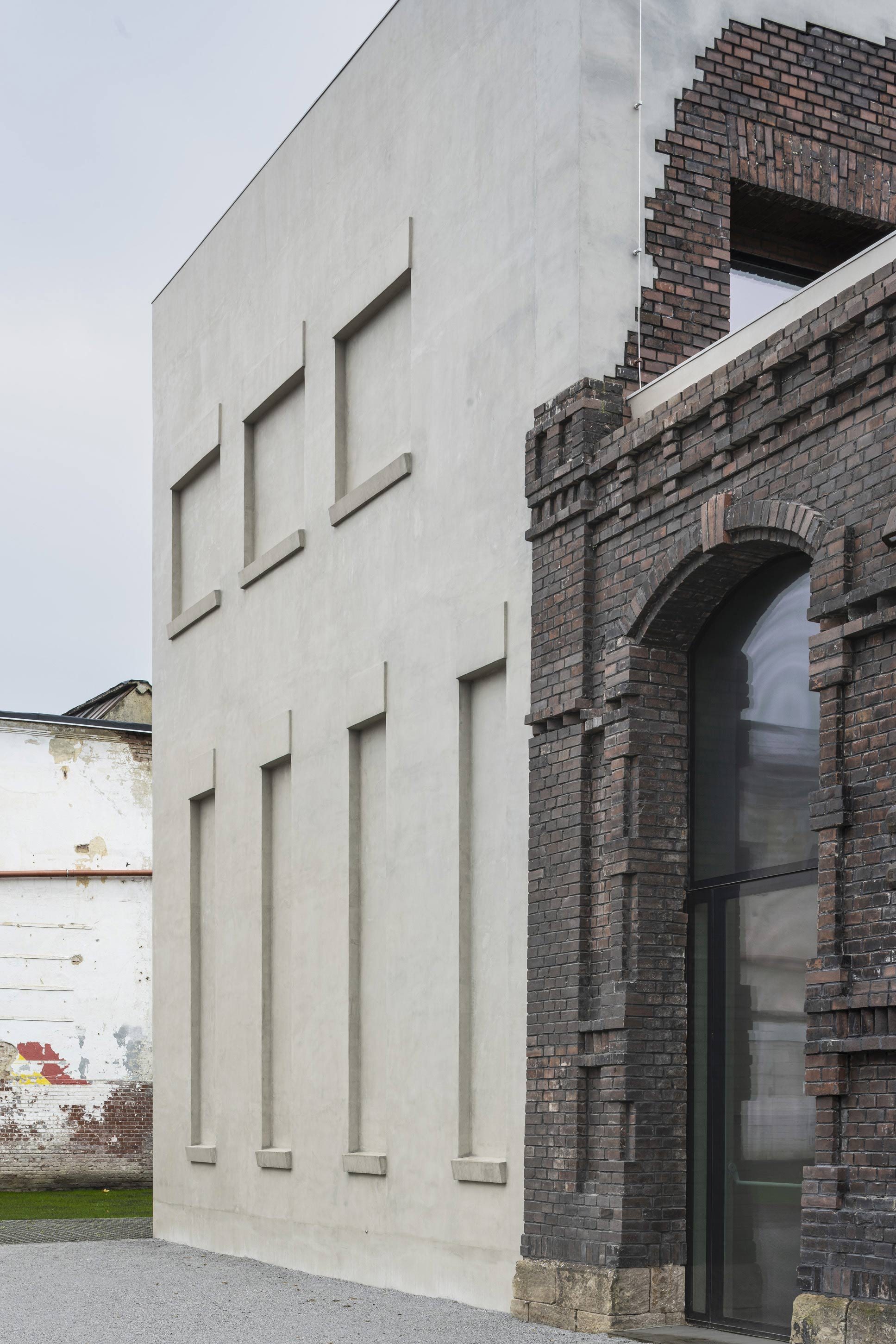本項目源於一項競賽,目的是將位於捷克奧斯特拉瓦市的一座破敗舊屠宰場改造為當代藝術畫廊。透過保護歷史建築並將其改造,使藝術更加親民、可被共享。我們以非常規的方式旋轉牆體,讓其延伸至建築外部,並將畫廊周圍受工業污損的空間轉變為多元生態藝術公園。
這座屠宰場牆體破損嚴重,多處穿洞,煙燻磚牆見證了城市的工業歷史。我們選擇面對這些時間落定的痕跡,並為這座建築增添新層次。我們保留了沾染污漬的磚牆和窗戶原有的特徵,使用現代材料填補牆體開口,同時保留古老裝飾,並採用微型混凝土重建已坍塌的部分。
該計劃的主要理念是保持入口的功能性,將其作為連接建築與城市的捷徑。新的旋轉門將展覽空間直接開放到室外,為藝術家和策展人提供展覽多樣的可能性,使藝術能真正地「走出」建築框架。這種流動性的意象使文化更加民主化,接觸新的群眾。
我們還參與了戶外區域設計,說服當局放棄混凝土鋪裝。受污染的土壤經修復後,建成了具有透水地面、花卉草地和蓄水池的生物多樣性公園。這創造了一個喚醒人們對藝術感知,也關注環境問題的包容性空間。
建築的原始主要材料是磚。損壞的磚塊多使用從坍塌部分搶救出的磚塊補充。新玻璃施以陶瓷絲網印刷,呈現深暗外觀,減弱畫廊光線。內部基於清潔衛生考量被刷白,展覽室採用白色石灰抹灰,覆蓋在礦物板隔熱層上。坍塌的木製屋頂被鋼結構和淺色膜材替代,減少升溫和熱島效應。
最重要的元素是六面旋轉牆:兩面作為建築入口,其餘連接畫廊與外部。儘管尺寸大,關閉時能完全密封,而地板下的機械裝置底座每年僅需一次簡單的維護。
The project came about as a result of a competition to turn a dilapidated old slaughterhouse in the Czech city of Ostrava into the PLATO Contemporary Art Gallery.
By saving a historic building and turning it into an art gallery, we have introduced a solution that makes art more democratic. By rotating the walls in an unusual way, it goes outside the building. We transformed the space around the gallery, which had previously been contaminated, into a biodiverse art park for the benefit of local residents.
The realisation is the result of an international competition to transform a dilapidated old slaughterhouse in the Czech city of Ostrava into the PLATO Contemporary Art Gallery. The walls of the slaughterhouse were dilapidated and battered in many places by huge holes. The soot-reddened brickwork bore witness to the city's industrial history. We took these deficiencies at face value and added another layer to the history of the building, which is under conservation protection. We were allowed to preserve the character of the soiled brick and the windows, and to fill in the openings in the walls with contemporary material while retaining the old ornamentation of the brick walls. We also used the adopted principle of recreating all non-existent elements of the building from micro-concrete to rebuild the collapsed section of the slaughterhouse.
The main idea of the project is based on maintaining the functionality of the openings as shortcuts connecting the building to the city. Hence the idea that their new infills could rotate and open the exhibition rooms directly to the outside. This has provided artists and curators with entirely new exhibition possibilities and allows art to literally 'go out' into the space around the building. Mobility has meant that culture, in the broadest sense, has the potential to become more democratic, as well as accessible to new audiences.
We were involved not only in saving the former slaughterhouse building, but also in the design of the outdoor areas even though this was not our task. We convinced the authorities to abandon the concrete paving. The contaminated soil there was rehabilitated and replaced by a biodiverse park with water-permeable floors, flower meadows and with retention basins. The layout of the greenery refers to the location of the buildings that once supported the slaughterhouse, and edible crops, also inside the gallery, complete the transformation of the site. The result is an inclusive space that sensitises not only to art but also to environmental issues.
The original dominant material of the building is brick. The destroyed bricks have been mostly replenished with those salvaged from a collapsed section of the building. The new glazing has a ceramic screen print, making it appear dark and dull, attenuating the light in the galleries.
The interiors were whitewashed for hygienic purposes, so the exhibition rooms are finished with white lime plaster laid over mineral board insulation. The building's soiled brickwork appears in the former atrium, now covered.
The partially collapsed wooden roofs covered with dark felt have been replaced with steel structures and covered with a light-coloured membrane. This allows the roofs to heat up less, without creating a heat island effect around them. The colour refers to the micro-concrete from which all the new and reconstructed elements are made. The most important of these are the revolving walls, of which there are six. Two are the entrances to the building, while the others connect the galleries to the outside. Despite their considerable size, they give a complete seal when closed, and the maintenance of the mechanisms hidden under the floor is simple and required once a year.
(全文請見《實構築》季刊24期)




